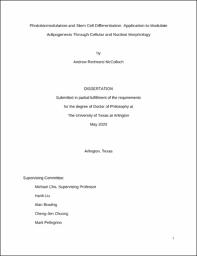
ATTENTION: The works hosted here are being migrated to a new repository that will consolidate resources, improve discoverability, and better show UTA's research impact on the global community. We will update authors as the migration progresses. Please see MavMatrix for more information.
Show simple item record
| dc.contributor.advisor | Cho, Michael | |
| dc.creator | Mccolloch, Andrew Redmond | |
| dc.date.accessioned | 2021-06-03T17:06:06Z | |
| dc.date.available | 2021-06-03T17:06:06Z | |
| dc.date.created | 2020-05 | |
| dc.date.issued | 2020-05-28 | |
| dc.date.submitted | May 2020 | |
| dc.identifier.uri | http://hdl.handle.net/10106/29866 | |
| dc.description.abstract | Mesenchymal stem cells (MSCs) are of great interest in regenerative medicine due
to their capability to self-renew and differentiate to various lineages. Typically,
differentiation to specific cell types has relied on the use of growth factors and other
reagents to provide an environment conducive to the desired cell type. More recently,
orthogonal cues other than chemical factors have been elucidated to regulate the lineage
commitment. For example, the cell shape, cellular mechanics and substrate stiffness
have been found to play a role in determining the fate of MSCs. However, it remains still
elusive how the morphological and mechanical changes in the nucleus are involved in
directing MSCs to the intended lineage. Using immunolabeling and computer-assisted
image analysis, the first aim is designed to elucidate changes in the nucleus during
differentiation to the fat-storing adipocytes.
Recent studies suggest that low level light exposure can serve as yet another nonbiological factor that can modulate the MSC differentiation. Referred to as photobiomodulation (PBM), it describes the influence of light irradiation on biological
tissues and has been shown to affect a variety of cells. Laser light in the near infrared
spectrum (NIR, 780 – 2500 nm) in particular has been shown to directly affect heme-containing proteins, changing their level of activity. NIR light has been used in the medical
field for analyses of cerebral blood flow. Recently, new evidence suggest light exposure
can alter stem cell differentiation, potentially by interacting directly with the heme-containing protein of oxidative phosphorylation, cytochrome C. The second aim of the
thesis is to apply NIR light exposure (1064 nm) to the cells undergoing adipogenic
differentiation and determine the effect of PBM on differentiated adipocytes.
Obesity, often caused by enlarged hypertrophic adipocytes, carries a multitude of
physiological risks including diabetes and heart disease. Interestingly, clinical trials of
photobiomodulation on obese participants has shown significant weight loss, suggesting
PBM may hinder lipid accumulation and regulate adipocyte maturation. However, such a
hypothesis remains to be validated, and the potential mechanisms need be understood.
In addition, to establish possible clinical efficacy, the effects of PBM must be quantitatively
determined in an in vitro obesity model. The third aim is to characterize the model and
apply NIR exposure (1064 nm) to examine a reduction in the lipid accumulation and
conformational and functional restoration of hypertrophic adipocytes. | |
| dc.format.mimetype | application/pdf | |
| dc.language.iso | en_US | |
| dc.subject | Stem cells | |
| dc.subject | Adipogenesis | |
| dc.subject | Photobiomodulation | |
| dc.subject | Low level laser therapy | |
| dc.subject | Obesity disease modeling | |
| dc.subject | Simulation modeling | |
| dc.subject | Nucleus | |
| dc.subject | Diabetes | |
| dc.subject | Reactive oxygen species (ROS) | |
| dc.title | PHOTOBIOMODULATION AND STEM CELL DIFFERENTIATION: APPLICATION TO MODULATE ADIPOGENESIS THROUGH CELLULAR AND NUCLEAR MORPHOLOGY | |
| dc.type | Thesis | |
| dc.degree.department | Bioengineering | |
| dc.degree.name | Doctor of Philosophy in Biomedical Engineering | |
| dc.date.updated | 2021-06-03T17:06:06Z | |
| thesis.degree.department | Bioengineering | |
| thesis.degree.grantor | The University of Texas at Arlington | |
| thesis.degree.level | Doctoral | |
| thesis.degree.name | Doctor of Philosophy in Biomedical Engineering | |
| dc.type.material | text | |
Files in this item
- Name:
- MCCOLLOCH-DISSERTATION-2020.pdf
- Size:
- 2.184Mb
- Format:
- PDF
This item appears in the following Collection(s)
Show simple item record


